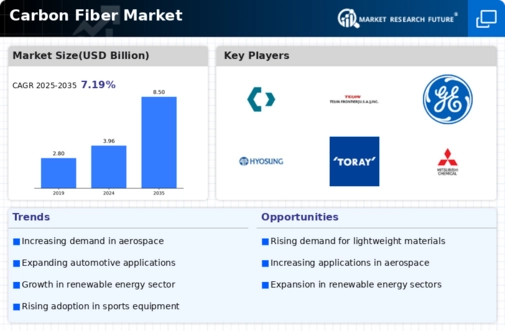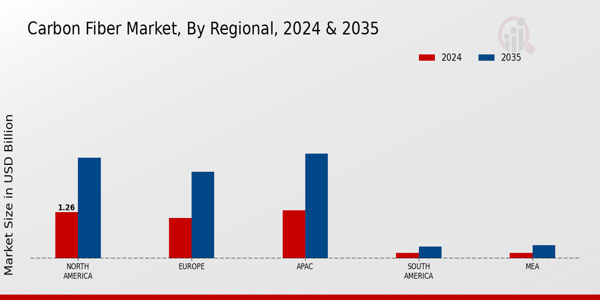Market Trends
Introduction
As we enter the year 2024, the carbon fiber market is on the verge of a major transformation driven by a number of macro-economic factors. The efficiency and performance of carbon fiber products are improving, and governments are putting pressure on industries to adopt lighter, more sustainable materials. The rising demand for high-performance materials in the automotive, aeronautics and wind energy sectors is reshaping the market. Strategically, these developments have important implications for the future of the industry, not only for the development and innovation of new products, but also for the positioning of companies in an increasingly eco-conscious market.
Top Trends
-
Sustainability Initiatives
The carbon fiber industry has recently begun to pay attention to the environment, and companies like Toray Industries have been making investments in the development of environment-friendly production processes. A major development is the use of reclaimed carbon fiber, which has seen an increase of about 20 percent in use by manufacturers. This not only reduces waste, but also appeals to the green-conscious consumers of the future. -
Advancements in Manufacturing Technologies
The new production processes, such as the automation of fibre placement and 3D printing, are enhancing the productivity of the process. These developments are being led by companies such as SGL Carbon. This technological evolution is expected to lower the cost of the material and improve its quality, which will make it more accessible to various industries. -
Increased Demand in Aerospace Sector
Carbon fibre is being used more and more in the aeronautical industry, where it is essential to reduce weight in order to improve the fuel economy. In its recent designs, General Electric has resorted to a thirty per cent increase in the use of this material. This tendency is bound to increase, the manufacturers being forced by the severest regulations to reduce the fuel consumption of their machines. -
Expansion in Automotive Applications
The development of carbon fiber has made it possible to develop the lightweight electric vehicle with the support of the chemical industry. In the automobile industry, the use of carbon fiber is expected to increase by 25 percent by 2025. As a result of the shift to energy-saving cars, the demand for carbon fiber is expected to increase by 25 percent. This trend has changed the supply and production strategies of the automobile industry. -
Growth in Wind Energy Sector
The wind-energy industry is increasingly using the blades of the wind-turbines made of carbon fibre, with companies like Hexcel supplying the material. In this application, the use of carbon fibre has increased both the strength and the performance of the machines, and has led to an increase of ten per cent in the yield of energy. This trend is expected to lead to further investments in the field of renewable energy. -
Emergence of New Market Players
New competitors are entering the carbon fiber field, and companies like Zoltek are extending their product lines. This influx of competitors is spurring innovation and driving down prices, bringing carbon fiber closer to parity with more conventional materials. The market is changing, and this change is leading to greater cooperation and even alliances between the established players and the newcomers. -
Regulatory Support for Advanced Materials
Governments are also increasingly encouraging the development of advanced materials, including carbon fibre, through tax breaks and other initiatives. For example, the US Department of Energy has set aside substantial resources for this research and development. These government-backed initiatives are expected to speed up the process of innovation and commercialization, which will lead to the further integration of carbon fibre into a wide range of applications. -
Integration of Smart Technologies
Embedding smart sensors in the material is becoming more and more popular. The materials used in carbon fiber products can be monitored in real time. This trend is best illustrated by the development of Hyosung’s smart textiles. The possibilities of enhanced functionality will open up new markets and new applications, especially in the aerospace and automobile industries. -
Focus on Cost Reduction Strategies
The cost of the material has remained a constant concern for manufacturers of carbon fibers, and the cost of raw materials and the cost of the process are still being studied. Companies such as Dow are seeking to lower costs by using alternative precursors. This is essential for the penetration of the market and the use of carbon fibers in a wider range of applications. -
Collaborative Research and Development
In recent years, the companies have been more and more involved in joint research projects to develop carbon fibre technology. The links between academic institutions and companies like Solvay encourage innovation. This type of partnership will speed up the development of next-generation carbon fibre materials, improving their properties and widening their range of applications.
Conclusion: Navigating the Carbon Fiber Competitive Landscape
In 2024, the carbon fiber market is characterized by intense competition and a high degree of fragmentation. Both the traditional and newcomers are competing for market share. Suppliers have to adapt their strategies to these developments. The old players use their supply chains and their brand name to create a certain degree of trust, while the new players use innovation and sustainability to carve out a niche for themselves. The ability to integrate advanced capabilities such as artificial intelligence, automation and flexibility is crucial for suppliers who want to be able to lead in this changing landscape. In the long run, suppliers who focus on sustainable issues will not only meet the regulatory requirements but also win over consumers with an increasing awareness of the environment. The strategic decision-makers must therefore be alert and agile, and constantly re-evaluate their position in this competitive environment.














Leave a Comment